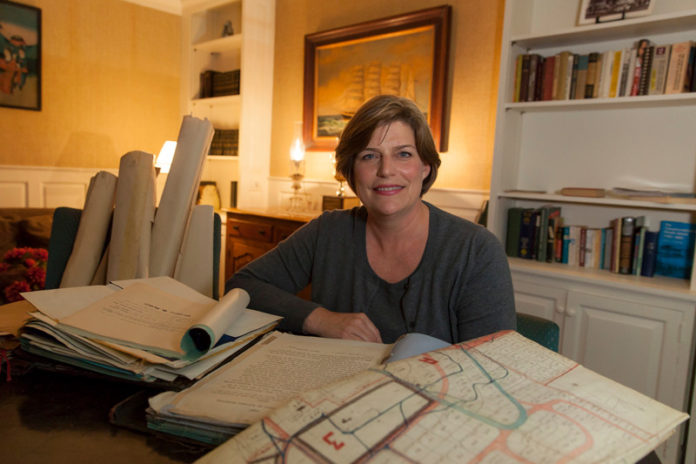
On Sept. 25, 1902, Capt. Nathanael Greene Herreshoff wrote a letter to the New York Yacht Club syndicate manager, claiming that his design for the next defender of the America’s Cup would be “a more powerful vessel than before.”
Seven months later, on a sunny, clear day in April, the 200-foot Reliance launched from the Herreshoff Manufacturing Co. yard in Bristol. The Reliance, the fourth defender of Herreshoff’s design, went on to win the 1903 America’s Cup and until the 21st century was considered the largest single-masted vessel ever built.
Constructing a boat of that size and complexity today would take two to three years, according to Larry Lavers, chief operating officer for the Herreshoff Marine Museum and America’s Cup Hall of Fame.
“They were extraordinarily good at lightweight engineering,” Lavers said. “They were among the foremost companies in the industrial revolution, one of the first to do materials testing and towing testing to see what different hull shapes would do, and they dabbled with advanced materials.”
How Herreshoff achieved such a quick turnaround, why the company was so successful and why it eventually went out of business in the 1940s are questions that have baffled researchers, but now a team of three students from Roger Williams University is working to find answers, thanks to the university’s Community Partnerships Center.
Twice a year, the center accepts applications from nonprofit organizations and government agencies in Rhode Island and southeastern Massachusetts looking to tap into the expertise of RWU students and faculty for projects they can’t afford to fund. In exchange, students earn course credit and real-world experience in their fields of study.
“Most organizations that come to us say, ‘We are so early in the process of looking at this mission that we can’t even get a grant,’ ” said Arnold Robinson, director of the Community Partnerships Center. “The analogy I use is that we like to do the first 10 percent of the project, get enough information for a nonprofit to put together funding to go find the professionals.”
For one such project, slated to begin early next year, students will organize and archive artifacts relating to the history of Mount Hope Farm, some of which date back to the mid-1900s or earlier. The farm, which was the site of the Wampanoag headquarters during King Philip’s War in the 17th century, dates back to the earliest days of Colonial America and is listed on the National Register of Historic Places.
“The farm has a huge history,” said Jennifer Bristol, executive director of Mount Hope Farm. “It’s a national historic site with a lot of history and available documentation on the property – maps, blueprints and communications, some going really far back. A lot of them are from Rudolph Haffenreffer, one of the most well-known private owners here.”
The documents have never been properly preserved or stored, Bristol said, and the longer they remain that way, the more likely they may become damaged and the history in their pages lost. Now, using the archiving equipment of the RWU history department, Bristol hopes to preserve digital copies of the artifacts and begin to discover what information they contain about the farm.
“It’s not enough just to figure out what it is,” Bristol said. “What does it tell us about the history of the farm? Why was it built this way? If there’s a clear vision there, the leadership of the farm has to say, ‘Is this a vision we want to adopt?’ ”
Bristol will meet this semester with Jennifer Stevens, assistant professor of U.S. History at RWU, and the four students who have chosen to participate in the project as part of an independent study, laying the groundwork for the archiving to begin in the spring. Bristol hopes this project will be just the first of many partnerships with the RWU Community Partnerships Center.
“We have a team here of six staff, maintaining the buildings and grounds, running a bed and breakfast, developing programs,” Bristol said. “That’s to keep our lights on. That’s what nonprofits do.”
Herreshoff Marine Museum archivist and librarian Norene Rickson – who has been working closely with the three RWU students analyzing payroll records, drawings and newspaper articles to unravel the inner workings of the Herreshoff Manufacturing Co. – echoed Bristol’s sentiment.
“It’s very time-consuming to gather the information and analyze it in a way that makes sense,” Rickson said. “We couldn’t do any of this without volunteers. We’re a small organization, and in a small organization, everybody does two or three jobs, so we really count on our volunteers.”
This project is one of seven collaborations between the Herreshoff museum and RWU. Last semester, RWU engineering students helped with the initial designs for a one-sixth scale model of the Reliance that the museum hopes to build as a visitor exhibit. Another project, still in the early stages of planning, will capture oral histories of the Herreshoff Manufacturing Co. through the words of local residents whose relatives worked in the shipyard.
Such community ties personify the Herreshoff mission to educate and inspire, and for Alex Rudkin, a senior marketing major at RWU and a hobbyist sailor, those ties were one reason he decided to participate in the project to analyze Herreshoff’s history.
“My grandfather was a member of one of the syndicates that sponsored America’s Cup boats,” Rudkin said. “Being able to tie that in and see how it was in the 60s and 70s and how it is now has been really interesting.”
Every Friday, Rudkin and his two teammates meet with Rickson and Sandy Lee, the Reliance replica project manager, to examine Herreshoff Manufacturing Co. microfilm archives gathered by the Massachusetts Institute of Technology. Their task is to document details about the company’s organizational structure and manufacturing process, and to find evidence supporting the long-held belief that Herreshoff’s success can be attributed to its uniquely advanced methodology.
“It was successful for 50 years and then it wasn’t,” Lavers said. “This was one of the largest employers in Rhode Island. Learning what was good about that and what wasn’t has got to be helpful at least historically and very likely in a real, practical sense.”
Meanwhile, the RWU Community Partnerships Center is gearing up for what Robinson calls the “Match.com” phase of the application process, when the center’s steering committee determines which projects will make the best match for RWU students and faculty. This semester, the center received more than 60 applications, up from just 10 applications when the center first launched the program in 2010.
“There is so much work you can do out there that’s also doing what I would call working for the public good,” Robinson said. “Yes, we want to educate, but we are not an ivory tower. Hopefully, we’re also having a positive impact.” •












